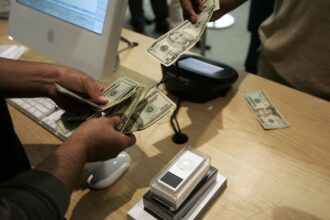Berkshire Hathaway (BRK/A, BRK/B) reported a loss of $12.8 billion in the third quarter versus a loss of $2.8 billion in the same quarter of 2022. Since results are heavily impacted by gains or losses from the investment portfolio, with unrealized losses from their portfolio included in earnings, the decline in the stock market made earnings reported earnings swoon. Operating earnings, which remove the distortion from market changes and better reflect the firm’s earnings power, rose 41% for the quarter versus 2022. Providing an illustration of the value from share repurchases, per-share operating income for the quarter increased by 43% compared to 2022.
Because the pandemic negatively impacted most businesses, including Berkshire, beginning in early 2020, comparing current results to pre-pandemic 2019 results is helpful. Year-to-date operating earnings for the third quarter of 2023 are 46% above 2019. Operating earnings increased over 2019 across all primary business segments except railroad and energy. Thanks to share repurchases, operating earnings per share for year-to-date 2023 were a whopping 65% above 2019.
A further look into the different operating segments for the third quarter of 2023 shows weaker results than in 2022, aside from the manufacturing, service, and retailing division and the insurance business, despite overall operating income increasing by 41% year-over-year. In a distinct change from 2022, the insurance segment has been the growth driver year-to-date, as operating income rose 165%, but excluding insurance fell by 12%.
Insurance: Third quarter 2023 investment income was 75% higher than in 2022, primarily due to higher interest income from short-term investments. As yields have rebounded from the ultra-low interest rates implemented in response to the pandemic, investment income has recovered from depressed levels. Due to easy comparisons, investment income should continue improving for the remainder of 2023, even though the Federal Reserve has paused its rate increases. Underwriting results were poor for the third quarter of 2022, with underwriting losses at all three insurance groups, but the most prominent coming from GEICO. Hurricane Ian contributed to the underwriting losses in the third quarter of last year. Unlike GEICO, Berkshire Hathaway Primary Group and Berkshire Hathaway Reinsurance Group had underwriting gains for 2022. In the third quarter, Berkshire’s insurance underwriting suffered no significant catastrophe events, defined as losses exceeding $150 million, and all three insurance units posted underwriting profits. GEICO had a solid third quarter thanks to increased premiums per auto policy and lower claims frequency. GEICO continues to suffer from rising claims severity due in part to the higher valuation of used vehicles. Despite the better results helped by higher average premiums, policies in force at GEICO have declined. A considerable reduction in advertising expenses bolstered profits. At the annual meeting earlier in the year, Ajit Jain, who oversees Berkshire’s insurance businesses, stated that GEICO had made “rapid strides” in telematics, which should help bolster underwriting profits over time. However, the company was still a ”work in progress.” Previously, GEICO was a growth engine for both profits and float, so progress in returning the company to its former glory should be watched closely.
The two most essential concepts in insurance investing are “float” and underwriting profit. In simple terms, float is created for insurance companies because insurance premiums are paid before any claims are made by the insured. Insurance companies can invest the float, sometimes for years, before insurance losses are reimbursed. Berkshire has a history, unlike many insurance companies, of earning an underwriting profit, meaning that their float costs them nothing and makes them money in addition to allowing them to earn a profit off of investing the float. As seen in the third quarter of 2023, an underwriting profit means the insurance premium exceeds all insurance claims and expenses. Despite Berkshire’s underwriting loss for 2022, it posted underwriting profits year-to-date in 2023 and for calendar years 2021, 2020, and 2019. Berkshire’s float was higher at approximately $167 billion versus the $166 billion level at the end of the second quarter and above the $164 billion on December 31, 2022. In general, the value of float increases as yields rise. Float per share has increased to $115,417 from $114,519 and $112,066 at the end of the first quarter and 2022, respectively. Share repurchases also aided this growth in float per share.
Railroad: Berkshire owns one of the largest railroads in North America, the Burlington Northern Santa Fe (BNSF) railroad, operating in the U.S. and Canada. Third-quarter operating earnings fell 15% and declined 17% year-to-date versus 2022. According to Berkshire, “the decreases were primarily attributable to lower overall freight volumes and higher non-fuel operating costs, partially offset by lower fuel costs.” The railroad was a relative underperformer in 2022, but most of the earnings weakness stems from economic rather than company-specific factors in 2023. Earnings are down year-over-year across the railroad industry.
Utilities and Energy: Berkshire owns 92% of Berkshire Hathaway Energy Company (BHE), which generally provides steady and growing earnings, as one would expect from what primarily consists of regulated utilities and pipeline companies. In addition, BHE typically produces significant tax credits due to its wind-powered electricity generation. Third-quarter operating earnings fell 69% and declined 46% year-to-date versus 2022. BHE set aside another $1.3 billion for possible losses from the wildfires involving PacifiCorp. Aside from the higher estimated wildfire liability, the U.S. utilities business looks to be operating as expected. This group also operates Berkshire Hathaway HomeServices (BHHS), the largest residential real estate brokerage firm in the country. The results show that the slowdown in housing activity remains evident, posting an 81.3% decline in year-to-date net earnings versus 2022. The 2023 BHHS earnings have suffered from lower transaction volume, mortgage, and refinance activity due to “the impact of rising interest rates, including lower existing home sales and mortgage refinancing demand.”
Manufacturing, Service and Retailing: This segment consists of many diverse businesses, so this analysis will focus on a few significant themes when looking at this segment. Berkshire’s aerospace exposure remains substantial despite selling its publicly traded airline holdings earlier in 2020. Berkshire previously took a $10 billion impairment charge on the Precision Castparts
PCP
After a 2022 boom year, housing-related businesses like Clayton Homes, Shaw, Johns Manville, Acme Building Products, Benjamin Moore, and MiTek posted lower quarterly and year-to-date earnings, at 5.6% and 10.8% decreases in pre-tax profits, respectively. The impact of higher home mortgage interest rates on home construction means that “we continue to anticipate certain of our businesses will experience weakening demand and declines in revenues and earnings into 2024.”
The most significant portion of the retailing segment is Berkshire Hathaway Automotive (BHA), which owns over 80 auto dealerships. BHA had 18.6% higher earnings for year-to-date 2023 compared to 2022, driven by “higher earnings from parts/service/repair and finance/service contract operations and lower operating expenses, partially offset by lower vehicle gross profit margin rates and higher floor plan interest expense.” New vehicle sales rose by 11.5% in the first nine months of the year, while used car sales declined by 4.6%. In addition, year-to-date 2023 earnings were lower for the other retailing businesses, which include Pampered Chef and See’s Candies, primarily due to the home furniture retailers, including Nebraska Furniture Mart. The home furnishing businesses have experienced “lower customer traffic,” with a 31.1% decline in earnings through September relative to 2022.
Berkshire’s McLane unit had 69.7% higher profits for the third quarter and year-to-date pre-tax earnings 53.2% above 2022. The improvement in earnings “reflects increases in the gross margin rates and lower fuel expenses, partly offset by higher personnel expenses.” McLane is a wholesale distributor to retailers and restaurants.
TTI
TTI
Pilot Travel Centers: Pilot is the largest operator of travel centers in North America, under the names Pilot and Flying J. In January 2023, Berkshire acquired an additional 41.4% ownership of Pilot for roughly $8.2 billion. As Berkshire’s ownership increased to 80% of the entity, it is now shown as a segment within the financials for the operating companies. According to management, Pilot’s “revenues and earnings are highly dependent on diesel fuel and gasoline volumes, prices and margins.” Pre-tax earnings fell by 59.5% for the third quarter and 44.3% year-to-date compared with 2022. Pre-tax earnings were hurt by “significantly lower fuel prices, as well as from lower fuel sales volumes,” while operating and interest expenses rose.
Non-Controlled Businesses: This segment includes companies’ profits that must be accounted for under the equity method due to the size of ownership and influence on management. The after-tax equity method earnings have Berkshire’s proportionate share of profits attributable to its investments in Kraft Heinz (KHC), Occidental Petroleum
OXY
Other: The segment had a gain in the quarter primarily due to foreign currency exchange rate gains generated from bonds issued by Berkshire Hathaway and denominated in British Pounds, euros, and Japanese Yen. These foreign currency liabilities are not a concern as Berkshire has significant assets and earnings denominated in these foreign currencies. Investment gains from non-U.S. dollar investments generally offset these losses and vice versa depending on currency exchange rates. Though overwhelmed by the currency gains, there were losses in the segment created by amortizing intangible assets connected to companies purchased by Berkshire. Finally, other earnings include “Berkshire parent company investment income and corporate expenses.”
Berkshire bought back almost $1.1 billion of its stock in the third quarter, down from $1.4 billion in the second quarter. Until an announcement in mid-2018, Berkshire had only made repurchases when the stock traded at less than 1.2 times the price-to-book (P/B) ratio. While that constraint is now relaxed, it is still a good indicator of the general range when aggressive repurchases will likely be seen. Berkshire’s price-to-book ratio was between 1.3 and almost 1.5 times during the quarter. Berkshire only intends to repurchase shares when the “repurchase price is below Berkshire’s intrinsic value, conservatively determined.” The price-to-book ratio remains a reasonable proxy for gauging Berkshire’s intrinsic value. Berkshire increased the pace of buybacks in September as the stock fell and valuation improved. Still, Warren Buffett and Charlie Munger’s judgment about its intrinsic value versus other available uses of capital can differ from that simple price-to-book measure.
In addition, Berkshire made other purchases but was a net seller of publicly traded stocks in the third quarter. Berkshire bought $1.7 billion of stocks while selling almost $7 billion for a net decreased investment of nearly $5.3 billion in publicly traded equities. A close review of the firm’s 10Q filing revealed that approximately $2 billion of Berkshire’s Chevron (CVX) holding was sold during the quarter. More details will be found in Berkshire’s 13F filing with the SEC, released in mid-November.
Berkshire Hathaway initially announced the acquisition of about 5% of five Japanese trading companies at the end of August 2020. These holdings are Itochu Corp., Marubeni Corp., Mitsubishi Corp., Mitsui & Co. Ltd., and Sumitomo Corp. Buffett revealed in April 2023 that Berkshire increased its stakes in these companies to 7.4%. Buffett indicated that these were intended to be long-term holdings, and Berkshire may still increase its stake to 9.9%. The 13F does not include international stocks.
Summary: Quarterly results are generally not meaningful for Berkshire since it is managed with a focus on increasing long-term value and not meeting quarterly hurdles. This ability to take advantage of time arbitrage has served the company and shareholders well over the years. The goal in looking at the results is to see if the segments are generally operating as expected and consider the capital allocation decisions made by Warren Buffett and Charlie Munger. In addition, reported earnings, which include realized and unrealized gains and losses, can obscure the true earnings power of the company.
While net earnings were reported at a $12.8 billion loss, operating earnings for the third quarter were $10.8 billion, rose by 41% over 2022, and are 33% above pre-pandemic 2019 levels. In recent years, a significant capital allocation decision was made to increase share repurchases. This activity signals that Buffett and Munger believe Berkshire Hathaway’s price is below their intrinsic value estimate, which should be a value-creator for the remaining shareholders. Operating earnings per share were 43% above 2022 and 50% above 2019, with the additional benefit from share repurchases.
Despite the solid operating earnings growth, Berkshire was not immune to the macroeconomic challenges. Berkshire’s third-quarter operating earnings, excluding the insurance segment, declined by 20% compared to the same quarter in 2022. As noted previously, weakness in railroad volumes and Berkshire’s significant exposure to residential housing have weighed on earnings outside of insurance. In addition, the utilities segment’s earnings were dented by the likely liability from wildfires. In addition, profit margins, excluding the insurance business, were down over three percentage points versus last year. So far, Buffett’s prediction at the annual meeting that most Berkshire businesses will likely have lower earnings in 2023 than the previous year has been correct.
Despite the expectation that most of Berkshire’s businesses would do worse, Buffett forecasted higher 2023 overall operating earnings at the annual meeting. Buffett noted that insurance underwriting does not “correlate with economic activity.” Higher bond yields have provided significantly higher investment income for Berkshire’s insurance business in 2023, growing 75% year-over-year. With the tailwind from the insurance segment, Berkshire’s third quarter and year-to-date operating earnings growth has materially outpaced the S&P 500.
Berkshire’s stock price outperformed the S&P 500 in the third quarter, rising by 2.6% versus a total return of -3.3% from the S&P 500. For 2023 through the end of October, Berkshire’s price is 10.5% higher, while the S&P 500 had a total return of 10.7%. Cash levels were $10 billion above last quarter. Berkshire retains a fortress balance sheet with cash and equivalents of almost $152 billion, providing flexibility to take advantage of opportunities, including repurchasing its stock. Berkshire has stated that there would be no stock repurchases if it would cause cash levels to fall below $30 billion.
Despite the advanced age of its two top leaders, Warren Buffett, CEO and Chairman, and Charlie Munger, Vice Chairman, Berkshire has a solid bench to continue managing the firm. Greg Abel manages the non-insurance business and is the architect of Berkshire Hathway Energy. Ajit Jain manages the insurance businesses and will continue to do so. Ted Weschler and Todd Combs already manage a portion of Berkshire’s publicly traded stock portfolio, among other duties. Berkshire is managed to survive and emerge stronger from any economic or market downturn, and that philosophy is not likely to change, given the culture. Buffett’s statement that Berkshire “will buy $50 billion of our stock if it makes sense” should comfort those worried about the stock dropping sharply when Buffett and Munger depart the firm.
Berkshire expanded the cash hoard on its Fort Knox balance sheet, allowing the unique ability to take advantage of investment opportunities in any downturn while virtually eliminating the risk of ruin. Despite the headline loss due to stock market weakness, Berkshire’s robust third-quarter operating results again illustrated the value of its diversified business mix. The insurance business more than offset the earnings weakness in many other business units.
Read the full article here










